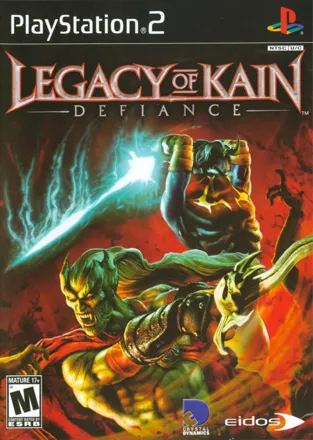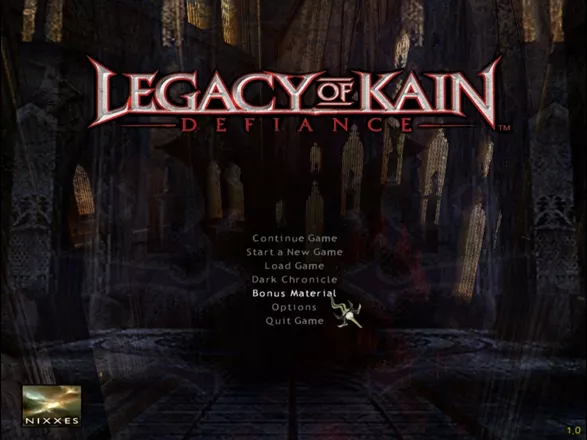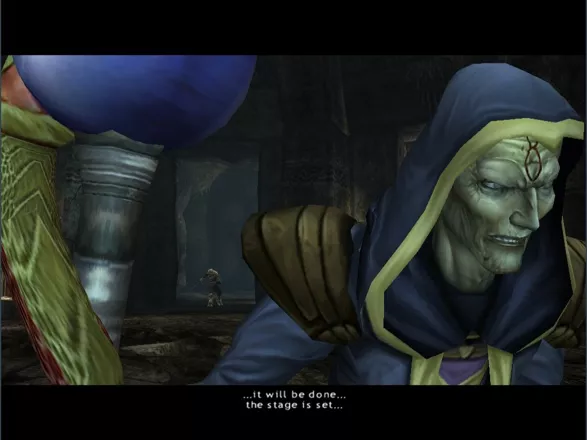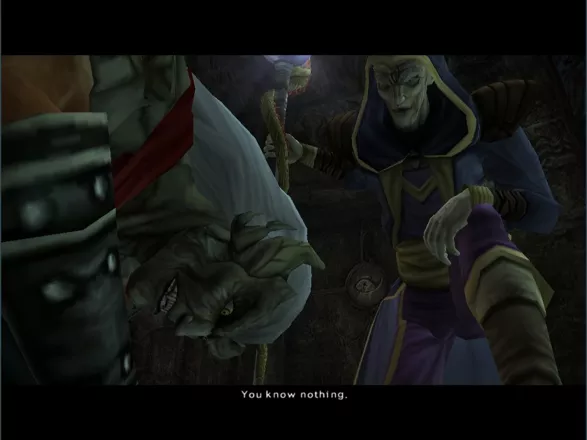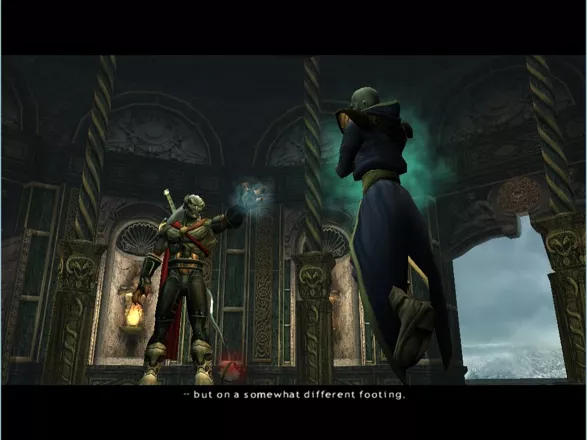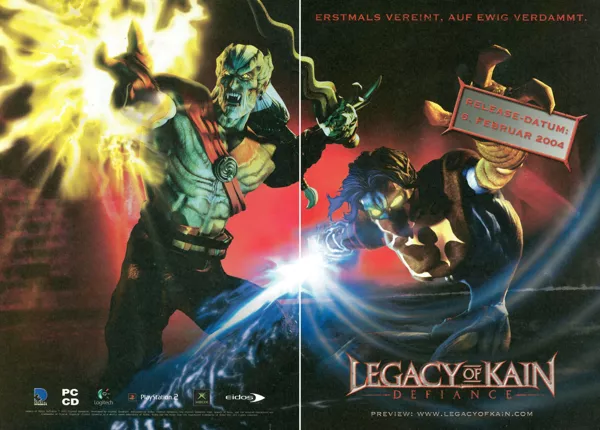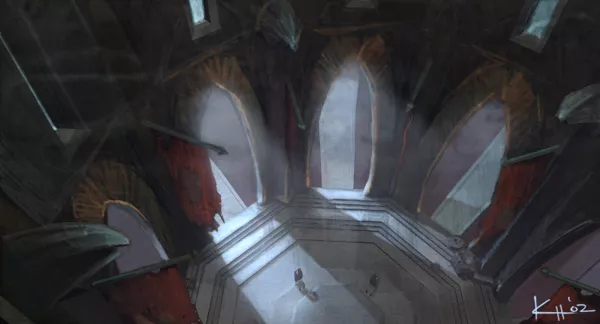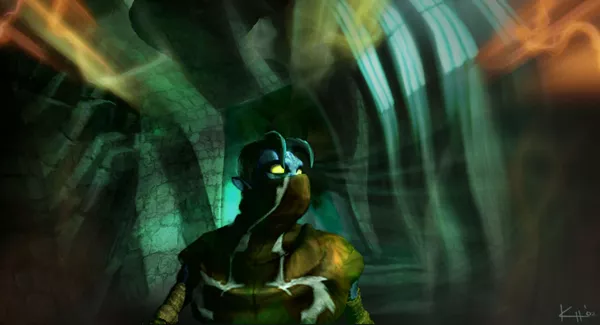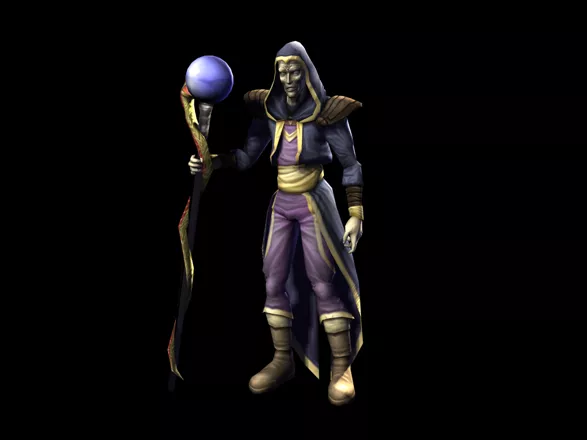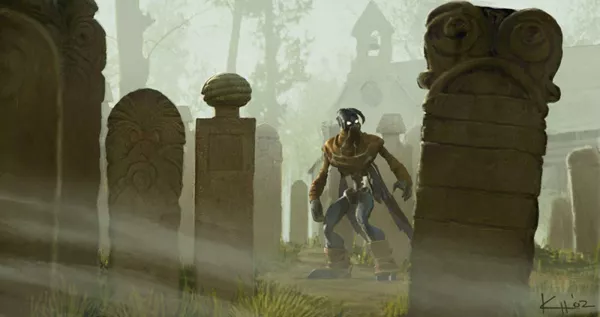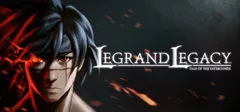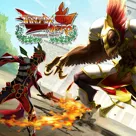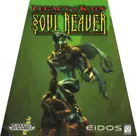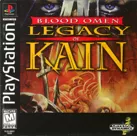Legacy of Kain: Defiance
Description official descriptions
Following the events of Legacy of Kain: Soul Reaver 2, Raziel and Kain were trapped in the Serafan fortress. Separated by sudden events, Raziel was forced to retreat into the spectral realm, leaving Kain to escape from the Serafan on his own. Both must escape the predicament they find themselves in and fight back against those who would seek to use them as manipulations in a grander plot. From both heroes cry out shouts of defiance, and a thirst to find the revelations that have been buried in the world of Nosgoth.
Legacy of Kain: Defiance is a third-person action game with light puzzle-solving elements, combining concepts seen in both Blood Omen 2 and Soul Reaver 2. The story unfolds through chapters, focusing alternately on Kain and Raziel as they pursue their separate, though intertwined quests. Control of each character alternates between levels, however both are controlled from a behind-the-shoulder perspective. While both heroes are different, they are similar in movement, ability to attack, defend, jump and access special abilities.
Kain and Raziel no longer pick up weapons, instead both using a form of the Soul Reaver weapon (Kain uses the physical sword form, Raziel uses an energy blade). Each Soul Reaver can now be "charged" to unleash a special ability, determined by the current alignment of Soul Reaver at the time. Both Kain and Raziel lose energy at a constant rate and must feed to replenish life energy (Kain feeds on the blood of living creatures, Raziel feeds on the souls of living and non-living creatures). And both Kain and Raziel feature telekinetic abilities to manipulate objects at a distance.
The two are, however, different characters that play differently, each requiring use of his talents, to bypass obstacles (sometimes the same obstacle). Kain focuses on strong combat and destructive abilities. He is able to power up the Soul Reaver weapon using properties of the Pillars of Nosgoth. Raziel is more subtle, able to use stealth and the phasing between material and spectral worlds in order to discover new paths. As in Soul Reaver, Raziel can phase into the spectral world at any time but must find a special location in order to phase back. Raziel powers up the Soul Reaver using elemental powers.
Spellings
- Наследие Каина. Defiance - Russian spelling
- 凯恩的遗产:挑战 - Simplified Chinese spelling
Groups +
Screenshots
Promos
Credits (PlayStation 2 version)
190 People (155 developers, 35 thanks) · View all
| Director | |
| Lead Programmer | |
| Programming | |
| Lead Designer | |
| Design | |
| Art Director | |
| Lead Artist | |
| Artists | |
| [ full credits ] | |
Reviews
Critics
Average score: 76% (based on 52 ratings)
Players
Average score: 3.8 out of 5 (based on 58 ratings with 5 reviews)
I wonder if you can SUE a developer for creating a game that gave you migraines?
The Good
Here's another GREAT case of creating a well-known love-able series into a pile of decomposing garbage. I think each game in the series had no doubt got worse. Legacy of Kain: Defiance has to my personal opinion, struck the final killing blow.
This this game didn't kill the series, if you've played the game and the series from the first Legacy of Kain, you might probably agree, it should of.
FYI, I couldn't finish the game because of major migraine problems.
The Bad
Well, the first thing you notice about the game is that they didn't bother to give you a walkthrough on the controls the first time you start playing. Next thing you know, you've got some guards attacking you and you've just figured out how to move but not how to attack.
I really don't think this game was meant for Windows. The playstation version might have been better suited for this game as this is a standard no-brain-er action game where most of the time all you do is run, jump, run, jump.
Have you every watched the movie Bourne Supremacy? That spy film starring Matt Damon. If you do, you'll probably remember how devastating the movie was to your eyes because the stupid director had this urge to tell the cameraman to move the camera in every direction possible instead of the actual part you want to see. The same problem exists in Defiance. When you move, the camera view point gets totally in the way. You can't see what's in front of you most of the time and in crucial areas which require you to act fast with jumping (or die), the camera also moves in the worst time possible...so often when you "thought" you were moving forward, the camera moves and your forward becomes side-ways. This is extremely frustrating when your about to jump from a ledge. Instead of jumping away from that oversided canyon, the camera view tends to make you jump INTO that dang canyon.
First the developers, should be shot. Then the game testers should be shot. Hell, everyone in the dang game should be shot. Except the voice-overs.
I don't know about you, but all that moving around with the camera going in every direction except where you want it to go, eventually developed to some some serious forms of migraines and vomiting tendencies. Each time the camera twirled, my head started spinning with it. I eventually gave up because my health couldn't keep up with my gaming stubbornness.
The Bottom Line
Even if your a fan of Kain series, I must warn you beforehand not try this game. It seriously isn't worth it...but if you insist, don't say I didn't warn you. My migraines haven't gone away...
Windows · by Indra was here (20754) · 2006
The Good
Given the choice; whether to rule a corrupt and failing Empire, or to challenge the fates for another throw, a better throw against one's destiny --what was a king to do?
Kain, the Vampire emperor, saw the beginning and the end of his story, and found the tale to be crude and ill-conceived.
He saw the strings of the puppetmasters that drove the land of Nosgoth to its demise.
He saw his lieutenant Raziel, predestined to be the messiah of the Vampire race, killing him, only to be later imprisoned inside the Reaver Blade, a legendary Vampiric sword.
***
Kain then decided to gamble everything in an attempt to rewrite history.
Kain eventually convinced Raziel to spare his life, and in the ultimate moment, saved him from being absorbed into the Reaver blade.
The plan worked...
Or did it?
Did Kain actually defy fate, or was his own plan also orchestrated by the mysterious puppetmasters?
***
Weakened to an unbearable level, Raziel shifted to the land of the dead --the Spectral Realm-- where an angry Elder God was waiting to punish him for his transgressions.
Kain was left alone in the castle of the Vampire-hunting order of warrior-priests known as the Sarafan, with the Reaver Blade in his hands, and suspicions of having been used as a pawn --again.
Thus, the fifth chapter in the legendary
DEFIANCE is a 3rd person perspective game with platforming, puzzles, and a strong emphasis in close-hand combat.
This time around, there are two major treats with which the developers have been teasing us for months:
1) a completely revamped combat interface and
2) the possibility to play with both heroes of the saga --the soul-devouring ghoul Raziel, and the almighty Vampire emperor Kain.
THE GRAPHICS: Dressed to kill
The first thing that shocks you when you fire up
Remember Avernus Cathedral? And Vorador's Mansion? Well...
DEFIANCE carries lots of new-generation special effects: fancy volumetric shading, blinding lighting, cubic-mapped reflections, water ripples... it's all there.
However, the real treat comes when we shift into the Spectral Realm. The Spectral Realm is basically a dark parody of the Material Realm: walls, columns, statues, trees --everything gets badly twisted, all colors turn to shady tones of blue, and soul-devouring vermin crawl out of the shadows.
In DEFIANCE, the Spectral Realm is decorated with eerie lighting, motion blur on EVERYTHING, and a disturbing soundscape of grim music and the tormented screaming of the dead. For the first time in the series, the Spectral Realm becomes an actually SCARY place.
Finally, congratulations Crystal Dynamics for the work in the program polishing dept:
First, like always, the game barely loads, ever. DEFIANCE does have some loading between levels, but it's barely long enough as to even read what the loading screen says.
Second, all this impressive package comes, once again, at almost no performance cost. Of course the game requires a T&L capable video card, but provided you have even the cheapest available one, you can raise all the details to the top and you will hardly perceive a slight stutter in the most crowded fights.
Finally, this game is the first one on the series (in fact the first one in a good while in PC gaming) which didn't require me to go look for a patch to fix some nasty bug before even getting to play it. In fact, I don't know if there IS a patch available, as I never needed one at all.
Of course, this is how all games SHOULD be, but...
GAMEPLAY: Step back, we have a winner!
Until now, I had the game
The combat interface is tremendously intuitive, you get to do a lot of stuff in no time, specially when it comes to fighting:
Two different kinds of normal attacks, five special upgradeable attacks, telekinetic blasts, telekinetic push & pull; and the combination of all of the above in any way you can imagine.
For example, you can lift an enemy in the air, jump after him, perform a three-hit mid-air combo, hold him floating with telekinesis, and then throw him on a lit torch, making him catch on fire and run around the room screaming in pain.
Or let's say you come out in the open, and three archers are shooting at you from a distance, on a higher floor. You can lift one of them with telekinesis, and then choose to throw him over his own comrades, push him down some abyss, or pull him down towards you: "I didn't hear you up there, dude. You were saying...?"
As you progress in the game, your character will learn new moves, and even though there are not as many attacks to learn as there were in
The lock-on-one-enemy-at-a-time thing has been removed, switched to a much more useful automatic system. Also, as well as enemies can gang up against you, you can attack several of them at the same time. Even if two of them come from opposite sides, you can get to do some elegant swings to give each of them some soup.
The seldom useful block function has been removed as well, and the dodge movement has been improved: it's a treat to use and to watch in action, specially Kain's dodge move, in which he turns to mist and literally passes through his enemies.
The game is divided in chapters, and each of them gives us the control of either Raziel or Kain, each following their own quests, until they ultimately meet. They basically share the same combat moves, but each one is best at a different thing, which nicely enhances the gameplay variety.
All that said, one thing you need to keep in mind is that, while it is technically possible to play the game with keyboard+mouse, not only I wouldn't recommended to do so: I'd say the use of a PS2-like dual-analog gamepad is simply mandatory. I know, PC games should be playable with the keyboard, gamepads are a console thing, blah blah blah --But let's face it: Most games out there are console ports nowadays, and gamepads for the PC can be found all over the place, and not only they're dirt-cheap, given the proper game, they're a pleasure to play with; so don't be such a wuss and go get one already.
I left for the ending of this section the camera --the most controversial feature of the game.
This is the fact: the camera doesn't follow the player over the shoulder in the classic 3rd person perspective, nor you can control it as in the last games of the series. Instead, it moves on a rail, zooming in and out, and changing perspectives every now and then. Crystal Dynamics called this a cinematic camera, and the visual effect looks pretty cinematic
alright.
I for one love the feeling, specially while fighting. I gotta admit, however, the system is not without some problems --we'll get back to this in a minute.
SOUND AND MUSIC: Still going up
In the sound dept, there's just one thing to say: DEFIANCE keeps with the astounding level of the series.
The voice acting, like I say all the time, is the best in any game I've known so far. Our favourite voice actors are all back, and once again they all do a magnificent job. As it happened in
The music doesn't deserve any special mention, except that as a fan of the series I found quite nice to hear many tunes from some of the previous games again.
THE STORY: Twisting by the pillars
After all the answers we got in the last chapter of the series, I wasn't hoping to be any more surprised now. I thought I had every possible plot fact DEFIANCE could bring figured out beforehand... I should have known better.
Moebius explained it clearly near the very beginning of the game: "you know nothing."
For one thing, we finally get to watch a scene we've been waiting for a really long time: Raziel versus Kain.
We know Raziel has been chasing Kain for as long as two full games already, and while his rage slowly cooled down with a number of intriguing facts he learned, he's far from calling his former master a friend.
We don't really know what Kain has in his mind, other than he constantly repeats that all his actions were orchestrated in order to help Raziel reclaiming his genuine destiny.
We also know that the primary objective of the game is to get both heroes to meet.
So WHAT happens once they meet?
Well of course I'm not answering that right here, but I will say this: the encounter alone makes the whole experience worth it --and I talk about all the 5 games.
Aside from this much-postponed memento, the game uncovers a truckload of events, enough to surprise even the sharpest-minded fan of the series.
How much does Moebius actually know? Did Kain ever met the Elder God? What were those demons stalking Raziel? What IS the source of Nosgoth's corruption? Who forged the Reaver? If Raziel actually is the Vampire messiah, does it mean there's some sort of Hylden messiah? How did the Ancient Vampires die? Who was the unspoken that brought
the destruction of the Circle of Nine?
All these questions, and some more, are going to be answered in this game. And believe me, you can't possibly guess one third of the answers.
Looking objectively, what Amy Hennig has been doing this far was taking some points of the first
Far from being this a negative criticism, I say she deserves to be applauded for the incredibly elegant way in which she ties up the loose ends. Looking at the full picture, it looks like a huge storyline which was carefully crafted eons ago. Each new chapter just makes it look even bigger.
Finally, we get to see a re-enactment of a couple of scenes from the first game, but shown from an alternative perspective that gives the whole situation a new level. In english: if you enjoyed the Malek cameo in
FREEBIES: Like a DVD
We usually accept the fact that porting a console game to the PC means losing all kinds of freebies to the lame small space of the CD-ROM --well no more!... Or kinda.
Our good friends at Crystal Dynamics noticed the game itself left a little room in the second CD, so they filled it up with as many freebies as they could. Of course, you won't be seeing the funny voice acting outtakes, but still you'll see some cool art concept and photographs of the DEFIANCE team.
The Dark Diary, a replay of the most important events in the game so far, is back and better than ever: this time you get to replay EVERY SINGLE cutscene seen. A great way of refreshing the events so far, or simply reviewing the best moments, which many developers out there should take notice of.
**The Bad**
STORYTELLING: For all those yellow mindless masses...
DEFIANCE is meant to attract both hardcore fans of the series and clueless newcomers, including those who are in for the fast-paced combat, the blood-splattering, and little more. To this end the storytelling was made as easy to follow
as it could.
Unfortunately, this means that the dialogues have been tuned down from smart double-senses and long rantings full of metaphors, to more concise and easy-going phrases. Hence, the cutscenes have lost half the class they used to have.
Kain saying stuff like "I could promise you a quick and painless death... but it would be a lie" makes him look like the uninspired villain of crappy cartoon, under the shadow of his infamous "Drop a stone into a rushing river..." metaphor in the previous game.
A boss character saying "No more questions. No more worship. Time to run. Time to scream. Time... TO DIE!" could be fine in a class-B horror flick, but it's just too cheap for this series.
I said the story is as brilliant as one could have expected, and it is; but there are a number of inconsistencies with previously known facts, like Raziel being able to climb walls in the Spectral Realm, or some deadly mist which has in Raziel the same effect that water has on common vampires.
These details are not as noticeable as to make a big deal of them, but LOK fans tend to be picky people, and at times, this game doesn't feel like LOKFan-proof.
GAMEPLAY: The flying beholder
Like I said, I DID like the cinematic camera, but I gotta agree that it becomes annoying in some parts. I don't care much about a swapping camera that suddenly makes left become right, or bumping against a wall because the camera was facing the character instead of the road —but I DO care about the camera changing perspectives in the middle of a jumping puzzle. Some jumping sections can turn into an incredible pain in the neck because of these swappings, and I remember at least one moment in which the perspective was so unfortunate that I
couldn't calculate the distances properly, which meant having to make a leap of faith towards a tiny thin piece of rock standing in the middle of a deadly pool of mist.
The difficulty level in the fights has been raised noticeably from previous games, but the combat interface makes up a good balance... except in one particular spot: the final boss fight.
It's not only the hardest fight in the game —it's downright annoying. The whole experience will take you about 30 minutes at a fairly fast pace, in a constant running and jumping to avoid attacks, while desperately trying to pass one or two hits every now and then.
I remember how in
Finally, the most worrying thing gameplay-wise has to be the puzzles. I already complained about the utterly silly puzzles in the misleading and almost forgettable
Most of the puzzles don't even feel like puzzles. They're so easy it's embarrassing to solve them.
When thinking about the innovative block puzzles in
LOCATIONS: Deja vu!
Even though the environments are beautifully designed and show a lot of class, I seem to feel
The backgrounds in DEFIANCE ARE very detailed, but not the "hey, Rahab has some seahorses carved in his armor!" kind of detailed.
Furthermore, at several points the game gets annoyingly repetitive.
In previous games we already had to do a lot of back-tracking into aleady visited places, but it wasn't necessarily bad, as the places would change dramatically with the time warping. However, this time you'll be returning up to three times to the EXACT same place.
Even worse, the Reaver Forges that Raziel has to visit in order to enhance his Wraith Blade are practically identical to one another. This means that 7 out of 15 chapters of the game are about navigating virtually the same place, in which you won't be doing much more than an eventual boss fight.
If that wasn't enough, 8 out of 11 boss characters in the game look EXACTLY THE SAME.
Also, note that when I mention Forges, you probably think of those enormous and magnificent temples we found in
These are the low-budget version of the Forges: modest circle-shaped two-tier buildings with 4 or 5 small chambers to visit. You'll be done navigating the whole place in less than 20 seconds.
SOUND ISSUES: A minute of silence
I don't know if this happens only to me, but some specific scenes of the game (including a few cutscenes) don't have any music. This is odd to say the least, since they are the kind of scene in which not only one would expect to hear music, but an enormous, ominous music as well.
The distinctive footsteps noise that so nicely would correspond every different kind of floor Raziel walked on in
CLIPPING: The bad cut
Last but not least, I need to mention the clipping issues. This series tend to be pretty buggy in the clipping section, but in this game I found some really nasty issues.
I have a few screenshots in which, for example, the cape of a given character comes forward and covers his legs in an impossible way, I saw Kain's hair pass through his own chest, I saw corpses dissappearing inside a wall, I saw enemies getting trapped behind decorative bars...
While most of these bugs are not deadly-serious, this is definitely an area to improve.
**The Bottom Line**
Even though the cinematic camera is a source of discussion, the
smooth combat interface alone undoubtedly makes DEFIANCE one of the best
third-person action games ever made.
Gameplay-wise, the only SERIOUS drawback I find is the simplicity of the puzzles.
With more
challenging puzzles, this game would have been just perfect.
To meet the demands of a mainstream market, the dialogues have been somewhat simplified, which is pretty sad to hear for us lovers of Kain's inspired rantings; but the story of DEFIANCE still sports everything you could ask for: charismatic characters, shocking answers, enigmatic questions, delicious cameos, and some massive plot branching & twisting.
DEFIANCE brings a beautiful conclusion to this legendary saga, and it's
also a great way to be introduced to the series: even if you dislike the
story, you WILL enjoy the gameplay anyway.
From any angle you look at it, DEFIANCE is a must have.
Windows · by Slug Camargo (583) · 2007
Defiant but not as one would expect
The Good
The ability to play as both Kain and Raziel is welcome. Various improvements to the combat system, with new abilities, combos and an overall more fluid control. General graphical and special effect update. Quality voice overs still present. Many of the series' past questions are answered.
The Bad
Camera is atrocious and often contributes to a sense of disorientation. Combat and puzzles are overly easy and only contribute to prolong what is otherwise a fairly short game. With one or two exceptions, both characters feel and play exactly the same. Many levels share the same design and feel repetitive. Music is mostly composed of variations of tunes which have been used before in the series. Very linear, and it also has the smallest gameworld in the series.
The Bottom Line
Defiant but not as one would expect
A long time sucking
Ever since the arrogant nobleman Kain took the chance to come back to life in the form of a bloodthirsty vampire to exact revenge against those who had murdered him in Silicon Knight’s Legacy of Kain: Blood Omen back in 1996, gamers have been drawn into the character’s dark tale. The plight of Kain to come to grips with his undead condition and to deal with the restoration of the Pillars of Nosgoth, the center of balance of the world, and the multiple machinations perpetuated by those that sought to control them has given way to one of the most popular videogame series, famous in so small part due to its seemingly endless plot twists and cast of characters.
One such character was developed for a title which took the series into a new direction. In 1999, Raziel, a former vampire inadvertently turned into a tormented soul-sucking wraith by Kain himself, was the star of Crystal Dynamics’ Soul Reaver. The game followed Raziel’s journey trough a Nosgoth corrupted by Kain’s decision of not restoring balance to the world, and his quest to take revenge against his former master. Raziel eventually confronted Kain but it proved useless, as the characters would endure much more before they destinies could be decided and the game ended with a cliffhanger. And even after two games later - Legacy of Kain: Soul Reaver 2 (2001) and Legacy of Kain: Blood Omen 2 (2002) - their stories seemed to be no closer to a resolution.
In 2003, Crystal Dynamics released Legacy of Kain: Defiance and with it aimed to answer many long time questions posed by the games’ intricate – and many would say convoluted – storyline, as well as finally revealing the destiny of all its major players. Defiance is clearly aimed at fans of the series and especially at several recurring complains made towards its gameplay shortcomings. Because of this, the game introduces some new gameplay mechanics as well as addressing some issues, but does it work as a whole?
Defiance it may have, but not as one would expect.
Will the real plot twist please stand up?
The Legacy of Kain series spans a centuries-old extensive storyline involving many different characters and situations, which is expanded in each new game. At his heart lie the chronicles of the vampire Kain and the wraith Raziel, two characters who have more often than not found themselves the unwilling pawns of greater forces at work in Nosgoth’s background. Further games in the series have exposed the struggle between the Vampires, the Hylden and one creature known as the Elder God, characters who have considerably manipulated everyone involved to such a degree that often some events won’t have an understandable result until several centuries have passed.
Plot progression in the series is generally detailed by the main playable characters during specific events, either as they appraise a situation or are engaged in dialogue with a supporting cast as they explore a dark fantasy land. The series has shown a considerable involving story, with a healthy combination of believable characters and their characterization as well as questioning the notions of fate and free will, but as the series advance it has caused some confusion among its followers. Since the story is largely built over elements of time travelling, dubious prophecies, and subtle machinations devised and executed by some characters, a game’s story can create events which will only be explained in a sequel or even make the characters live trough events which happened in a prequel but from different perspectives. This has made many fans question the continuity of the storyline.
Defiance does the hard task of answering many of these questions, including the resolution of the prophecies, and the destiny of nearly all characters involved as well of characters long thought to be gone. Long time fans will be pleased to know that nearly everything comes full circle for characters such as Moebius, Mortanius, the Elder God, and Ariel. Even Turel – the mysteriously absent vampire lieutenant from the first Soul Reaver title – makes a great appearance that ties him into the very first title of the series in a surprising way.
While Defiance is clearly aimed at long time fans of the series, it’s surprising to see there isn’t much done to fill in some new players to the series. While Soul Reaver 2 had included an introduction movie that condensed the events that happened in Soul Reaver, Defiance does not do this to bridge the gap between itself and Soul Reaver 2. Instead, it includes an introduction movie that does little else than the one used in Soul Reaver 2. There’s some dialogue along the game that clarifies matters a bit but it never feels enough. If they want to get up to date, they will have to read the manual. To their credit however, Crystal Dynamics have included a ‘Dark Chronicle’ option as in Soul Reaver 2, which will permit players to see trough any story-related movie or cutscene that they come upon in the game.
But while it’s true much of it will be answered by the end of the game, there will still remain situations which will be unexplained. To make matters worse, the progression of the narrative is generally slow paced but in the last moments of the game players are thrown many twists, surprises and general odd moments. Because of this, it’s questionable that Defiance will be the conclusion of the series some believed it to be.
The vampire in me is the vampire in you
Defiance’s main feature is set to please some long time fans, in particular those who have fervently expressed the desire to play as both Kain and Raziel. Throughout the span of the game, players will take turns controlling either one of them as they advance trough the levels. The gameplay mechanics are almost the same as past titles, with only the more basic ones still being present in regards to control or character skills. Kain can explore Nosgoth and go trough the game’s levels by use of unique skills. Raziel also has some unique skills but has one ability that is tied into his condition as a spectral agent. At any time he can shift into the Spectral Realm, a bleak version of Nosgoth which exists at its twisted counterpart. It is a realm of lost souls trying to adjust to their surroundings and escaping the vicious attacks of spiritual wraiths who try to consume them, and it also twists some constructions found in the Material Realm.
This is paramount to solving some puzzles and navigating some areas of the game which Raziel goes trough, as sometimes a path may be blocked in the Material Realm but may have an opening in the spectral version, a ledge may be only reachable as it is twisted into a lower position in the spectral realm, or an entity holding power over something in the material plane can actually be found in the spectral one. Also, Raziel cannot pass trough barred gates or similar impediments in the same way as Kain, who can pass trough them as mist; he must go into the Spectral Realm in order to pass trough them, and this often makes it so his levels take longer to finish because of this very mechanic. Shifting back to the Material Realm involves finding a conduit that will allow Raziel to teleport back; these conduits are scattered throughout the levels but sometimes may be guarded by strong wraiths. Kain on the other hand doesn’t need to do this but he will perish if he touches water while Raziel can deftly swim trough it. Another change to the gameplay is that Raziel now dies if all his energy is lost in the Material Realm, instead of being teleported to the Spectral Realm.
It’s unfortunate, however, that the main attraction of the game is also the one that comes out being the one that is less developed. For the most part, Kain and Raziel play exactly the same. Aside the aforementioned differences, nearly all else is the same. They can both climb walls with jagged textures, they can both leap and glide down to the ground below, they can both sneak, pass trough barred gates and broken windows, and use telekinetic powers to break walls or manipulate characters or objects (which for the most part will be clearly identifiable as breakable). However, Raziel’s ability to constrict targets or manipulate objects by running in a circle around them is gone, and so is his ability to crouch then jump to perform a higher jump. And Kain’s ability to momentarily possess targets or to perform high distance jumps towards unsuspecting targets or distant locations is gone as well; instead, like this is replaced with the ability to perform these long distance jumps between only in specific points highlighted with a red circle, and can only jump into predetermined platforms.
In the end, most differences feel superficial and it’s a shame that more wasn’t done to flesh out the uniqueness of the characters in terms of control, and that things that would further distinguish them were removed.
Nosgoth, why do you torment me so?
Kain and Raziel’s story in Defiance is played out in a series of levels which are mostly exclusive to each character, although some levels will intertwine. For story reasons which I will not spoil, Raziel will find himself thrust 500 years into Nosgoth’s past while Kain will start out exactly where Soul Reaver 2 ended, in a present day Serafan Stronghold. As the game progresses, Raziel and Kain will sometimes find themselves in levels where one or the other has passed previously but this has little if any ramifications other than superficial changes made to suggest the passing of time or someone’s presence. It would have been interesting to have the actions of Raziel in the levels which occur in the past to cause some impact in the places where Kain travels to in the present such as opening alternate or secret paths, but there’s almost no situations where this happens. When it does happen, it’s because characters need to progress and as such changes made in the past would have had a future consequence regardless. Perhaps having to deal with a similar concept for the Spectral Realm limited development time for this element to be further developed, but it’s a shame this wasn’t better integrated.
Even the concept of travelling trough time in Nosgoth, while initially appealing, isn’t executed all that well. It’s hard to believe that in 500 years Nosgoth shows little change in its vast landscape. You know you’re in its past and in its present mostly because you know each character is played out trough a unique time period. Shifting between the Material and Spectral realms with Raziel shows more changes to the gameworld’s landscape than this.
The first Soul Reaver and the second Blood Omen games made extensive, and some would argue boring uses of unnecessary environmental puzzles or key hunts to the point where it felt like they were simply there to slow down progress. Soul Reaver 2 considerably used less puzzles which in turn provided a better flow to the entire game. Defiance is a mixed bag. It features many situations where one particular important-sounding item must be found or one particular event must be triggered, which just leads to much backtracking peppered with some combat situations. But perhaps more damning is that these puzzles and combat scenarios are some of the easiest in the entire series, and it’s pretty disappointing that they sometimes feel detached from the game or do nothing but slow you down. Even Kain will have a couple of snide remarks about this very thing, which leads me to believe since the developers couldn’t get rid of pointless combat and puzzles then they decided to mock them. It’s also pretty bad when you stumble upon a particular situation and see it repeated many other times as the game progresses, such as statues that come to life once you activate something, or the need to light braziers in some order so you can keep going.
As players travel trough Nosgoth they will find collectibles which will give additional benefits to both Kain and Raziel. Health Talismans increase each character’s health for every three talismans acquired, while Telekinetic Runes increase the power of Kain and Raziel’s telekinetic powers. There are also Ancient Tomes which will unlock additional content in the form of concept and promotional artwork, 3D models and assorted info across all games of the series. Players who finish the game will also have access to a “Making Of” of the game, although this is largely comprised of the same previously mentioned material but exclusive to Defiance.
Reaver me this
As in previous titles of the series, combat has an important role. Throughout various parts of the game enemies will actively seek out characters and will try to kill them, and fortunately Defiance sports enough changes to the standard combat model that would easily marks it as the best system in the series were it not for some drawbacks. Gone from previous games is the ability to use the weapons of killed enemies as secondary weapons; this has mostly to due with the fact that Kain carries the Soul Reaver and Raziel’s wraith version of it no longer requires him to be at full health in order to manifest itself. Gone are also the characters’ ability to block incoming blows, which means you’ll have to use dodge and jumps to avoid blows instead.
One of the most noticeable change is that characters will gain further combat abilities the more enemies they kill. You’re told when a character acquires a new ability via a small pop-up window, and more information about it can be seen on a character’s status screen along with the necessary movements to pull it off. There’s a total of 5 abilities to be learned for both characters, and each has different uses. For instance, Kain’s Cadaverous Laceration will allow him to perform a flurry of stabbing attacks, while Raziel’s Phantasmal Tempest will have him performing slashing combos in the air which will hit anyone in its radius. These abilities, coupled with other standard ones such as dodging or using telekinetic blasts to repel enemies can make combat very satisfying and with a certain edge to it. You’ll often find yourself performing some quick and outlandish moves to dispatch foes, and the smoothness of the system just makes it all feel very intuitive. Unlike previous games in the series, combat won’t feel a chore in terms of control and you’ll likely hunt out for some enemies to try out newly gained abilities and combos.
Each character will also be able to forge their respective Reaver blades with various additional attributes. Among these are attributes such as Dimensional and Time for Kain’s sword, and Light, Fire and Earth for Raziel’s blade. A small bar will fill the more hits a character lands in combat and once it’s filled a special attack may be unleashed. With a charged Dimensional Reaver, Kain can land additional damage to surrounding enemies when he deals the last blow of a three-hit combo; whereas with a charged Fire Reaver, Raziel will be able to incinerate all enemies within the blast’s radius. Aside combat, some of these reavers will have other effects, such as the Earth Reaver which will create temporary stone platforms, and will also allow Raziel to become heavy and therefore able to walk underwater, while the Water Reaver will allow him to freeze an waterfall so he can climb it.
However, it’s far from being perfect.
The main drawback is that the combat abilities are exactly the same for both characters, with only their names changing. This was another opportunity to make them distinct individuals that was lost and with the exception of Reaver abilities you’ll rarely notice any difference in combat between them. Aside feeding habits, Kain still has a clear sadist nature to him, as seen when he laughs at an impaled victim or when he says his signature line “Vae Victus!”, but even these smaller touches are inferior to their original incarnations. There’s simply no “Vae Victus!” like the original. Some of the basic abilities also get reduced in importance. You can no longer use telekinesis to control an enemy in air into all directions, you can only hold him in position and either use that time to attack, or throw him into a handful of directions. Stealth is also downplayed since there are very few opportunities to use it; it could be useful to avoid pointless combat and just go by unnoticed in some level segments, but it won’t work.
Reaver effects are also mostly of predictable use in the game’s puzzles, and while they all have different combat effects their application is actually quite similar: whether you’re burning foes in an area with the Fire Reaver or pushing back and stunning enemies with the Air Reaver, the idea is always the same, to momentarily gain the upper hand or to slow enemies down. In this regard, Kain’s Reaver effects are much less than Raziel’s but are more varied in combat. Also, some effects come so late into the game that their use will be little and limited to a couple of obvious situations.
Enemy intelligence has taken a severe hit. One of the natural extensions of Kain and Raziel’s condition is their predatory hunger which means that at some point they have to feed in blood or souls. As was previously possible to do, they can attack an opponent until it is near death and then feed on it. In previous games there was some care required as enemies could interrupt this feeding and cause even more damage to a character with his guard down. Not so in Defiance, as enemies will not attack the characters while they are feeding off near death foes or performing a killing blow to them. This is just one of those situations that have no particular justification and end up having a negative impact on combat, especially in cases where exits in combat areas are closed until characters kill all enemies. What’s the point in this? There’s no sense of danger if Kain or Raziel can feed without enemy interference.
But perhaps the worst offender to the entire game that just ruins much of the experience is the camera. Simply put, this is the worst camera system in the series. Instead of using the standard camera mode, Crystal Dynamics saw fit to include a camera mode which attempts to give a cinematic feeling. This works well in scenes where appraisal of backgrounds can be done, but it’s terrible when players are exploring or are involved in combat. With the camera showing you the action from unlikely places you’re going to run into problems. Sometimes you’ll fight enemies off the screen, sometimes you’ll be attacked and won’t know where attacks are coming from. Sometimes the camera follows the characters from their front and the game expects us to fight enemies which are ahead of us. I found myself drawing enemies into areas where I could see what was happening otherwise my character would keep getting pummeled. It’s also a common occurrence to be pressing a direction to enter an area but when you enter it the camera has changed places and the button coordination is switched back, making it so the character will go back to the area he was in if you keep pressing the same button. This was one of the things that was painfully obvious they shouldn’t change – yet they did. Granted, there is an additional firstperson perspective but it’s only there to look at surroundings, not to navigate trough them.
Also, am I the only one to think that seeing characters jumping into the air and performing combos has more to do with a game like Devil May Cry or Dragon Ball Z than it does with Legacy of Kain? For some reason this seemed to evoke images of acrobatic and zany moves which feel somewhat cartoony and ouf of place in a game which has tried to take itself seriously over the years.
The coin is still turning
Defiance probably has some of the best graphical depictions of all the 3D iterations of Nosgoth, with very detailed constructions and decorations although there’s not much variety to locations; since most of the time both characters will go trough the same levels the quality of the textures and artwork loses to repetition. An example comes from ancient vampire ruins or the entrance to Reaver chambers, which are made up of the same basic renditions with only a handful of changes to texture and colors really making them different. The Spectral Realm is also very detailed with even more twisted paths and distorted chambers; wandering, afflicted souls are more lifelike in appearance and no longer generic energy forms floating about. It also uses a blur effect surrounding the scene which gives a sort of ghostly and spiritual feel to it, along with background voices giving off a sense of loss and despair. All of this combined has me believe this is quite likely the best vision of the Spectral Realm to date.
Characters and animations are also very adequate, and are often accompanied by nice touches – such as Raziel pulling souls out of dying enemies – which help it all come together, but for the most part character movement and combat is so fast you won’t be seeing the animations in detail. Graphics are of higher quality than past titles and there are some nice blur and particle effects as well. Although the standard higher resolution support is included in this port, some textures still seem a bit washed out and lifeless; you’re also likely to encounter console leftovers in the form of heavily pixelated trees. There’s also a surprising lack of polishing in some models’ textures which show pixels floating around some of their parts, though you’ll likely be too busy playing than noticing these things. Nonetheless there’s a satisfying amount of supported tweaking in the form of different resolutions, buffering and vsync options to name some.
Voice overs in the series have always been of high quality and Defiance is no exception, as it’s top notch and still succeeds in providing great fan service by recruiting previous artists to perform their roles again. Included are Michael Bell (Raziel), Simon Templeman (Kain), and Tony Jay (Elder God), and their work is still great. On the other hand, music doesn’t seem to get as much attention; while it does its job it’s mostly composed of reworked versions of past tunes in the series and strangely there’s no music in Raziel’s Spectral Realm. Sound effects are pretty basic as well.
There are also some collision detection problems. Sometimes characters will enter combat mode and face an enemy but the enemy is behind a wall or below ground. Other times enemies will get trapped into the background and won’t be able to leave it; if you’re fighting in one of those areas which has placed barriers on its exits until all enemies are dead, better load a previous save. And speaking of saves the PC port of Defiance uses checkpoints like the console versions which means that even if you save further down one level, a save will record all you’ve done but will have you start out from the last save point you reached. I also suggest getting a gamepad to play trough the game because you’re in for trouble if you try playing it with the keyboard.
Final Words:
I really wanted to like Legacy of Kain: Defiance, but it is a mixed title. On one hand it improves on the combat system trough the use of character abilities, combos and an intuitive control system. The story for the most part is gripping, the characters remain well defined, and the game is generally fast paced enough. The ability to play as Kain and Raziel is a welcome addition, and graphics are overall solid.
However, the good stuff is not good enough. Combat is incredibly easy and so are the puzzles, which just convince me more that they are only there to inflate playtime. The camera is very atrocious. With the exception of a couple of things, the main characters generally play and feel like the same. It’s also the smallest and most linear game of the series which wouldn’t be bad in itself except it’s littered with things that plague, rather than help, the series. Even the inevitable confrontation between both of the main characters feels much less than what it could have been.
In the end it’s a satisfying game experience which is worth playing trough at least once, but not one you’ll want to return to again after you’ve completed it. Go for a rental or a bargain bin price.
Windows · by Diogo Ribeiro (332) · 2006
Discussion
| Subject | By | Date |
|---|---|---|
| A new title?!?!?!?!?! | Donatello (466) | Aug 23, 2012 |
Trivia
References
- There is a cheat code that replaces Kain's weapon with a cardboard tube, with Kain uttering "Fear the Tube". This is a reference to the popular web comic Penny Arcade and its "Cardboard Tube Samurai" character.
- In one of the larger rooms in Vorador's Mansion, you can see a large painting. It is a portrait of a woman's face. However, the interesting thing is that she may be a reference to Umah, the female vampire from Blood Omen. If you look closely at her forehead and the sides of her face, you can make out tattoos similar to Umah's. In fact, one event that was removed from the game was the appearance of a pre-vampiric Umah.
Turel
The boss monster Turel, who Raziel encounters later in the game, was cut from the very first Soul Reaver. Although Turel was mentioned in Legacy of Kain: Soul Reaver as one of Kain's vampire clan leaders and his disciples could be found in the game, he himself was missing without any plot-related explanation. Furthermore, a strategy exploiting Turel's weakness is needed to defeat him in Defiance, similar to the bosses in Soul Reaver.
Information also contributed by Mark Ennis and Terok Nor
Analytics
Upgrade to MobyPro to view research rankings!
Related Sites +
-
Legacy of Kain: Defiance
Official Website -
Legacy of Kain: The Lost Worlds
Website dedicated to the 'lost' content of the games in the Legacy of Kain series. Missing bosses, areas and plotlines that might have been.
Identifiers +
Contribute
Are you familiar with this game? Help document and preserve this entry in video game history! If your contribution is approved, you will earn points and be credited as a contributor.
Contributors to this Entry
Game added by Slug Camargo.
Additional contributors: Unicorn Lynx, Indra was here, Shoddyan, Qlberts, Kit Simmons, Klaster_1, Patrick Bregger.
Game added December 30, 2003. Last modified March 17, 2024.
